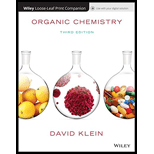
(a)
Interpretation:
Draw the product direction of
Concept Introduction:
Acid-Base Reaction: This type of chemical process typified by the exchange of one or more hydrogens ions H+, between species that may be neutral molecules or electrically charged ions.
Chemical equilibrium: The term applied to reversible
(b)
Interpretation:
Draw the product direction of chemical equilibrium position should be identified.
Concept Introduction:
Acid-Base Reaction: This type of chemical process typified by the exchange of one or more hydrogens ions H+, between species that may be neutral molecules or electrically charged ions.
Chemical equilibrium: The term applied to reversible chemical reactions. It is the point at which the rate of the forward reaction is equal to the rate of the reverse reaction. The equilibrium is achieved; the concentrations of reactant and products become constant.
(c)
Interpretation:
Draw the product direction of chemical equilibrium position should be identified.
Concept Introduction:
Acid-Base Reaction: This type of chemical process typified by the exchange of one or more hydrogens ions H+, between species that may be neutral molecules or electrically charged ions.
Chemical equilibrium: The term applied to reversible chemical reactions. It is the point at which the rate of the forward reaction is equal to the rate of the reverse reaction. The equilibrium is achieved; the concentrations of reactant and products become constant.
(d)
Interpretation:
Draw the product direction of chemical equilibrium position should be identified.
Concept Introduction:
Acid-Base Reaction: This type of chemical process typified by the exchange of one or more hydrogens ions H+, between species that may be neutral molecules or electrically charged ions.
Chemical equilibrium: The term applied to reversible chemical reactions. It is the point at which the rate of the forward reaction is equal to the rate of the reverse reaction. The equilibrium is achieved; the concentrations of reactant and products become constant.
(e)
Interpretation:
Draw the product direction of chemical equilibrium position should be identified.
Concept Introduction:
Acid-Base Reaction: This type of chemical process typified by the exchange of one or more hydrogens ions H+, between species that may be neutral molecules or electrically charged ions.
Chemical equilibrium: The term applied to reversible chemical reactions. It is the point at which the rate of the forward reaction is equal to the rate of the reverse reaction. The equilibrium is achieved; the concentrations of reactant and products become constant.
(f)
Interpretation:
Draw the product direction of chemical equilibrium position should be identified.
Concept Introduction:
Acid-Base Reaction: This type of chemical process typified by the exchange of one or more hydrogens ions H+, between species that may be neutral molecules or electrically charged ions.
Chemical equilibrium: The term applied to reversible chemical reactions. It is the point at which the rate of the forward reaction is equal to the rate of the reverse reaction. The equilibrium is achieved; the concentrations of reactant and products become constant.
Trending nowThis is a popular solution!

Chapter 9 Solutions
ORGANIC CHEMISTRY-PRINT COMPANION (LL)
 ChemistryChemistryISBN:9781305957404Author:Steven S. Zumdahl, Susan A. Zumdahl, Donald J. DeCostePublisher:Cengage Learning
ChemistryChemistryISBN:9781305957404Author:Steven S. Zumdahl, Susan A. Zumdahl, Donald J. DeCostePublisher:Cengage Learning ChemistryChemistryISBN:9781259911156Author:Raymond Chang Dr., Jason Overby ProfessorPublisher:McGraw-Hill Education
ChemistryChemistryISBN:9781259911156Author:Raymond Chang Dr., Jason Overby ProfessorPublisher:McGraw-Hill Education Principles of Instrumental AnalysisChemistryISBN:9781305577213Author:Douglas A. Skoog, F. James Holler, Stanley R. CrouchPublisher:Cengage Learning
Principles of Instrumental AnalysisChemistryISBN:9781305577213Author:Douglas A. Skoog, F. James Holler, Stanley R. CrouchPublisher:Cengage Learning Organic ChemistryChemistryISBN:9780078021558Author:Janice Gorzynski Smith Dr.Publisher:McGraw-Hill Education
Organic ChemistryChemistryISBN:9780078021558Author:Janice Gorzynski Smith Dr.Publisher:McGraw-Hill Education Chemistry: Principles and ReactionsChemistryISBN:9781305079373Author:William L. Masterton, Cecile N. HurleyPublisher:Cengage Learning
Chemistry: Principles and ReactionsChemistryISBN:9781305079373Author:William L. Masterton, Cecile N. HurleyPublisher:Cengage Learning Elementary Principles of Chemical Processes, Bind...ChemistryISBN:9781118431221Author:Richard M. Felder, Ronald W. Rousseau, Lisa G. BullardPublisher:WILEY
Elementary Principles of Chemical Processes, Bind...ChemistryISBN:9781118431221Author:Richard M. Felder, Ronald W. Rousseau, Lisa G. BullardPublisher:WILEY





